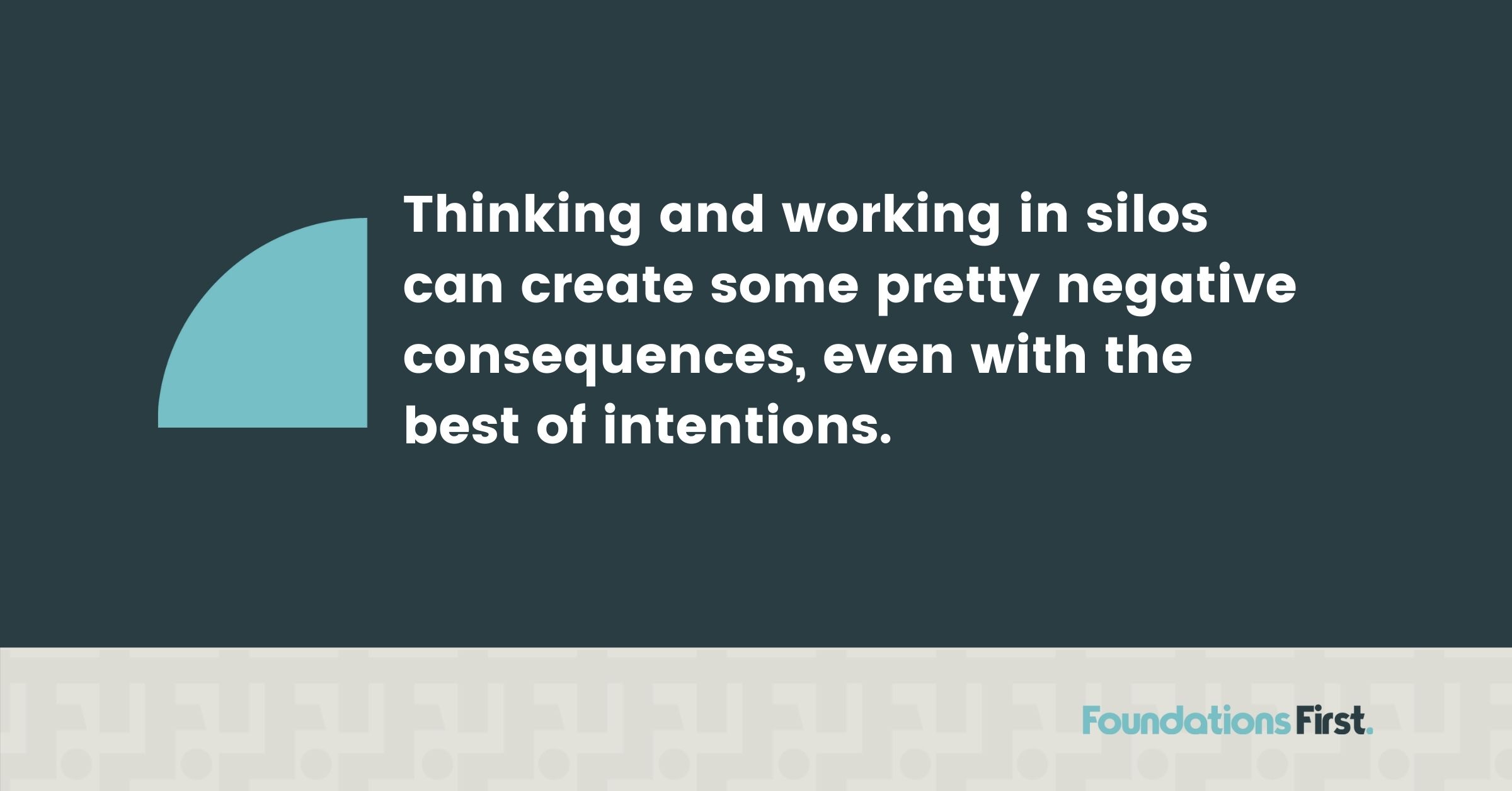Why Message-Driven Digital Marketing Wins

Foundations First Marketing has long geeked out on data. Numbers don’t just tell us the outcomes of our efforts and where we need to improve—they tell us everything. We review and analyze the hell out of various metrics to ensure our clients get a positive, measurable return on their digital marketing investment. While we may not be alone in our data-driven approach (a quick Google search of “data-driven digital marketing” fetches about 65,700 results), we are willing to bet there are few digital marketers as passionate as we are about data—and about using it to get you results.
Building a Cohesive Digital Strategy
Often, clients who come to us for help have organizations filled with what we like to call “data-driven channel captives”—marketers who shamble from their silos at a day’s end mumbling about click counts and cost per lead figures. Trust us, we get it: in digital marketing, hitting key performance indicators (KPIs) can be the difference between paying the mortgage and, well, searching for another gig. Thinking and working in silos can create some pretty negative consequences, even with the best of intentions. When we examine a company’s digital marketing plan, we keep an eye out for those consequences—disparate messaging, organizational redundancy, turf warriors, and (gulp) no authentic means for effectively marketing to customers.
When we see these signs—and once we’ve regained our composure—we get to work building a focused, collaborative digital marketing strategy. We develop a compelling message that screams value to your customers. And we find that message in—you guessed it—data.
Our customer-focused, message-driven digital marketing approach:
Understands Customers: Uses data to understand customers’ needs at every stage of the customer journey.
Connects Silos: Connects each silo to the core message/campaign. This means all channels work together toward an articulated and unified goal.
Creates Content: Creates content that is relevant, consistent, and valuable, enhancing the customer experience at every step of the journey.
Engages Customers: Connects and engages customers, improves conversions, and drives customer loyalty.
1. Use data to understand customers’ needs throughout the customer journey.
Let’s face it: the days of tidy, linear paths toward positive purchasing decisions are history. Most customers loop de loop across multiple devices, through multiple channels, over multiple timeframes. These journey patterns can be tough to track and optimize for a customer base whose preferences seem to grow more elaborate by the minute.
A better use of your resources is to combine your efforts and channel your data.
By doing so, you’ll better understand your customers and all the different ways in which they engage with your brand. When your cross-channel team augments that data with a focused audit, you can answer:
What do you know about your customers?
What are their behaviors, activities, and social media interactions? Do you get your customers’ likes, dislikes, habits, fears, and challenges? To reach them emotionally, you need this data.
At what point in the online journey are you losing customers?
Is it cart abandonment? If so, why are they abandoning? Unexpected shipping costs? Losing interest after being prompted to create an account? Over half of abandonments are for those two reasons, so how will you fix those?
Do you provide a consistent customer experience across all channels?
If you can’t answer this question in the affirmative, it’s time to herd cats. Companies that provide a streamlined, device-agnostic user experience retain an average of 89% of their customers, while companies with weak omni-channel strategies keep only 33%. It’s simple. Customers want to know what to expect from your brand.
Is the customer persona you have up to date?
Has it changed? You may very well have a boatload of numbers around what leads your target audience to your online doorstep, but we recommend taking it a step further. Do you have enough information to draw accurate conclusions on your customers’ emotional buying decisions? Plus, since you most likely have different sets of buyers, you’ll probably need more than one persona.
Are you finding data gaps?
It is when you’re working together, across channels, that gaps become really obvious.
To which competitors are you losing customers?
What can you learn from those competitors? We provide you with critical data on what your competitors are doing, so you can adjust accordingly and gain a competitive advantage.
2. Connect each silo to the core message/campaign. This means all channels work together toward an articulated and unified goal.
Data from all channels drive the message.
Once you’ve collated data from sales, customer success managers, digital strategists, and all digital channel managers, you can begin to write the message which, when all is said and done, should reflect a unified goal.
Foundation First’s message-driven approach is holistic.
We expect all channels to communicate back and forth, working together to drive leads. Individual channel success will rise and fall with the rest of the group. For example, if SEO is weak, then that will hinder the effectiveness of the other channels.
When all channels unify around a message, they all work toward the same goal.
That is, a campaign succeeds or fails as a whole. Channels increase marketing opportunities, qualify leads, and sell. Whether the goal is promoting brand awareness or launching a product, all channels need to retain the integrity of the message, which means we must be strategic with the channels we utilize, implementing the most effective solution on a case-by-case basis. Well-analyzed data should tell us more than what happens or in what channel it occurs—it should tell us why a tactic succeeded or failed. When we know the “why,” we can adjust for the next campaign.
Create content that is relevant, consistent, and valuable, enhancing the customer experience at every step of the journey.
Develop appropriate content emphasizing awareness, evaluation, consideration, try or examination, buy, repeat and refer.
The message drives appropriate campaigns across all channels.
It unifies and advances all efforts toward that articulated and unified goal. Our message-first strategy provides consistent messaging for the customer and reduces company waste. For example, according to the Content Marketing Institute, 60-70% of B2B content created is never used, the most cited reason for which is irrelevancy. Content is expensive to produce. A message-driven strategy ensures your content investment will be of real value to both your customers and your company—and data tells us this is the case.
3. Engage customers, improve conversions, and drive customer loyalty.
A lot goes into creating a great customer experience. You need to capture, engage, and inspire your customers to convert—and maintain their loyalty once they do. Each company has to find its own unique recipe for success. Focus on:
- customer experiences.
- how to communicate your big ideas across channels and at all stages of the customer journey.
- any potential limitations that the data reveal.
- what part of the marketing funnel and customer journey you are addressing.
- your campaign’s purpose (building awareness, improving conversions, or boosting consumer loyalty).
Look around your company. Are there data-driven channel captives staring at screens? Messaging that swings from one extreme to the other? Customers outing you on Facebook for having no easy communication conduits?
Cindy Powell
Categories
- Analytics and Measurement
- Brand Messaging
- Competitor Analysis
- Content Marketing
- Digital Marketing Strategy
- Digital PR & Events
- Marketing Budgets
- Marketing KPIs
- Marketing News
- Marketing Rock Samples
- Marketing Staffing & Vendors
- Marketing Strategy
- Marketing Tech Stack
- Podcast
- Product Marketing
- Sales Marketing Alignment
- SEO
- Social Media
- Strategic Marketing Partnerships
- Target Markets
- Uncategorized
- Vision & Purpose
- Webmaster








